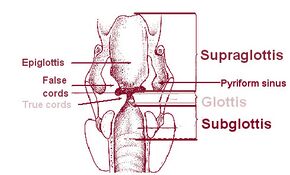Medicine:Piriform sinus
| Pyriform sinus | |
|---|---|
 Pyriform sinus, a part of hypopharynx | |
 The entrance to the larynx, viewed from behind, with Pyriform sinus labeled at bottom left. | |
| Details | |
| Identifiers | |
| Latin | recessus piriformis, sinus piriformis |
| Anatomical terminology | |
On either side of the laryngeal orifice in humans is a recess, termed the piriform sinus (also piriform recess, pyriform sinus, piriform fossa, or smuggler's fossa), which is bounded medially by the aryepiglottic fold, laterally by the thyroid cartilage and thyrohyoid membrane. The fossae are involved in speech.
The term "piriform," which means "pear-shaped," is also sometimes spelled "pyriform" (as in the diagram on this page).
Deep to the mucous membrane of the piriform fossa lie the recurrent laryngeal nerve as well as the internal laryngeal nerve, a branch of the superior laryngeal nerve.[1] The internal laryngeal nerve supplies sensation to the area, and it may become damaged if the mucous membrane is inadvertently punctured. Found in laryngopharynx easilly The piriform sinus is a subsite of the hypopharynx. This distinction is important for head and neck cancer staging and treatment.[2]
The term smuggler's fossa comes from its use for smuggling of small items.[3]
Clinical significance
This sinus is a common place for food particles to become trapped; if foreign material becomes lodged in the piriform fossa of an infant, it may be retrieved nonsurgically. If the area is injured (e.g., by a fish bone), it can give the sensation of food stuck in the subject's throat.[3]
Remnants of the pharyngeal pouches III and IV may extent to the piriform sinus as sinus tracts which are sometimes imprecisely called "fistulas".[4][5] This can result in acute infectious thyroiditis which is more common on the left side of the neck.[6]
References
- ↑ Moore, K.L., & Agur, A.M.R (2007). Essential Clinical Anatomy: Third Edition. Baltimore: Lippincott Williams & Wilkins. ISBN:978-0-7817-6274-8
- ↑ AJCC Cancer Staging Handbook: From the AJCC Cancer Staging Manual, Sixth Edition. Ed. Frederick L. Greene, M.D. page 48.
- ↑ 3.0 3.1 Singh, Vishram (4 March 2014). Textbook of Anatomy Head, Neck, and Brain;. Elsevier Health Sciences. p. 203. ISBN 978-81-312-3627-7. https://books.google.com/books?id=bNTgAwAAQBAJ&pg=PA203.
- ↑ Koch, Bernadette L.; Hamilton, Bronwyn E.; Hudgins, Patricia A.; Harnsberger, H. Ric (22 November 2016). Diagnostic Imaging: Head and Neck E-Book. Elsevier Health Sciences. p. 611. ISBN 978-0-323-44314-2. https://books.google.com/books?id=wgCRDQAAQBAJ&pg=PA611.
- ↑ Lucente, Frank E.; Har-El, Gady (2004). Essentials of Otolaryngology. Lippincott Williams & Wilkins. pp. 281–2. ISBN 978-0-7817-4707-3. https://books.google.com/books?id=m1uW6zW6BvgC&pg=PA281.
- ↑ Gorbach, Sherwood L.; Bartlett, John G.; Blacklow, Neil R. (2004). Infectious Diseases. Lippincott Williams & Wilkins. p. 462. ISBN 978-0-7817-3371-7. https://books.google.com/books?id=91altE1evAsC&pg=PA462.
External links
- Anatomy photo:31:17-0105 at the SUNY Downstate Medical Center - "Pharynx: The Laryngopharynx"

